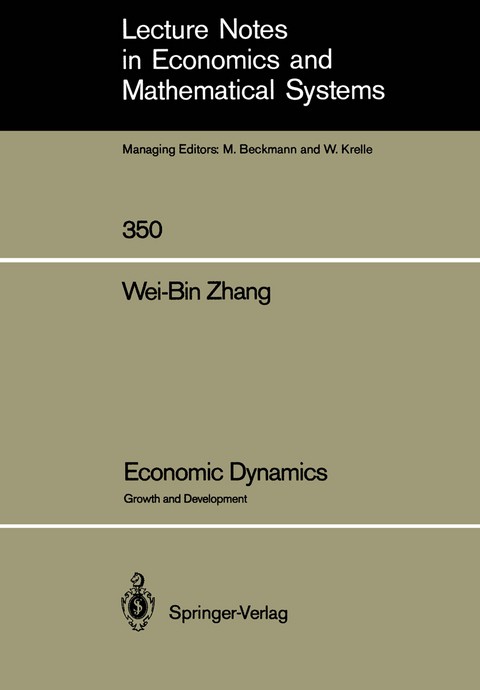
Economic Dynamics
Springer Berlin (Verlag)
978-3-540-53217-0 (ISBN)
I. The Economic Development Problem.- 1. Economic Development.- 2. A General Historical Sketch of Growth Theory.- 3. Development Indicators.- 4. Short Term versus Long Term.- 5. Fast Variable versus Slow Variable.- 6. Equilibrium versus Non-equilibrium.- 7. Stability versus Instability.- II. Growth Theory Revised - From Quantitative Aspect.- 1. The Neoclassical Approach to Growth.- 2. The One Sector Model of Technological Changes Within the Framework of the Neoclassical Approach.- 3. A Growth Model With Exhaustible Resources and Endogenous Population.- 4. Distribution of Income and Wealth in the Neoclassical One Sector Growth Model.- 5. The Two Sector Models.- 6. Multiple Sector Models - The extended neoclassical model.- 7. Production Functions in Growth Models.- III. A Revision of Real and Monetary Dynamic Models.- 1. Money in Economic Theory.- 2. The One Sector Model With Money Within the Framework of the Neoclassical Approach.- 3. On the Generalized Tobin Model.- IV. Prices, Growth Rates and Interest Rates in the Dynamic Context of Multisector Models.- 1. Introduction.- 2. The Input-Output System With Neoclassical Production Functions.- 3. The Existence of Short-Run Equilibria With Endogenous Interest Rate.- 4. The Existence of Equilibrium for a Fixed Interest Rate.- 5. The Interest Rate and Investment Coefficient Matrix.- 6. The Relations Between Growth, Interest and Inflation Rates in the von Neumann Dynamic Model - An extended concept of balanced growth.- V. Growth Rate Controlled and Economic Dynamics in a Multisector Model.- 1. Introduction.- 2. Economic Dynamics With Maximization of Welfare.- 3. Economic Cycles in the Case of One Sector.- 4. Properties of the Multiple Sector Model.- 5. Stabilization With Growth Rate Adjustment.- 6. Further Interpretationsof the Dynamic System.- 7. Conclusions.- VI. The Choice of Techniques.- 1. The Choice of Techniques in a Simple Growth Model.- 2. The Basic Model of Leontief Technology and Some of Its Fundamental Properties With One Technique.- 3. The Model of Leontief Technology With Many Alternative Techniques.- 4. Dynamic Behavior of the Model With Many Alternative Techniques.- 5. The Impossibility of Reswitching in the Continuous Substitution Model.- VII. Technological Policy and Economic Development - A Neoclassical Approach.- 1. Technological Change in Economic Development.- 2. The Model.- 3. Equilibrium and Stability.- 4. The Effects of Changes in Some Parameters.- 5. Effects of Changes in the Population Growth Rate in the Case of Instability.- 6. Conclusions.- VIII. Technological Policy and Economic Development - Multisector Approach.- 1. The Basic Model.- 2. Some Properties of the Basic System.- 3. Technological Change of "Learning by Doing".- 4. Technological Change due to Investment in Training.- 5. A Growth Model of "Hybrid" Technological Change.- 6. Some Comments.- IX. Conclusion and Prospects for Further Research.- 1. Summary.- 2. How To Close Dynamic Models - The neoclassical, neo-Marxian and neo-Keynesian approaches.- Appendix. Nonlinear Dynamic System Theory.- A.1. Ordinary Differential Equations and Existence of Solutions.- A.2. Stability.- A.3. Linearization Principle and Its Valid Domain.- A.4. Limit Cycles in Two Dimension - The Poincaré-Bendixson theory.- A.5. Bifurcations.- A.6. Limit Cycles - The Hopf bifurcation theorem.- A.7. Maps.- A.8. Chaos.- A.9. The Logistic Map - An example of chaos.- References.
| Erscheint lt. Verlag | 14.11.1990 |
|---|---|
| Reihe/Serie | Lecture Notes in Economics and Mathematical Systems |
| Zusatzinfo | X, 232 p. 2 illus. |
| Verlagsort | Berlin |
| Sprache | englisch |
| Maße | 170 x 244 mm |
| Gewicht | 441 g |
| Themenwelt | Wirtschaft ► Volkswirtschaftslehre ► Ökonometrie |
| Schlagworte | Development • Entwicklung • growth • Inflation • Structural Changes • Strukturwandel • Wachstum |
| ISBN-10 | 3-540-53217-X / 354053217X |
| ISBN-13 | 978-3-540-53217-0 / 9783540532170 |
| Zustand | Neuware |
| Informationen gemäß Produktsicherheitsverordnung (GPSR) | |
| Haben Sie eine Frage zum Produkt? |
aus dem Bereich


